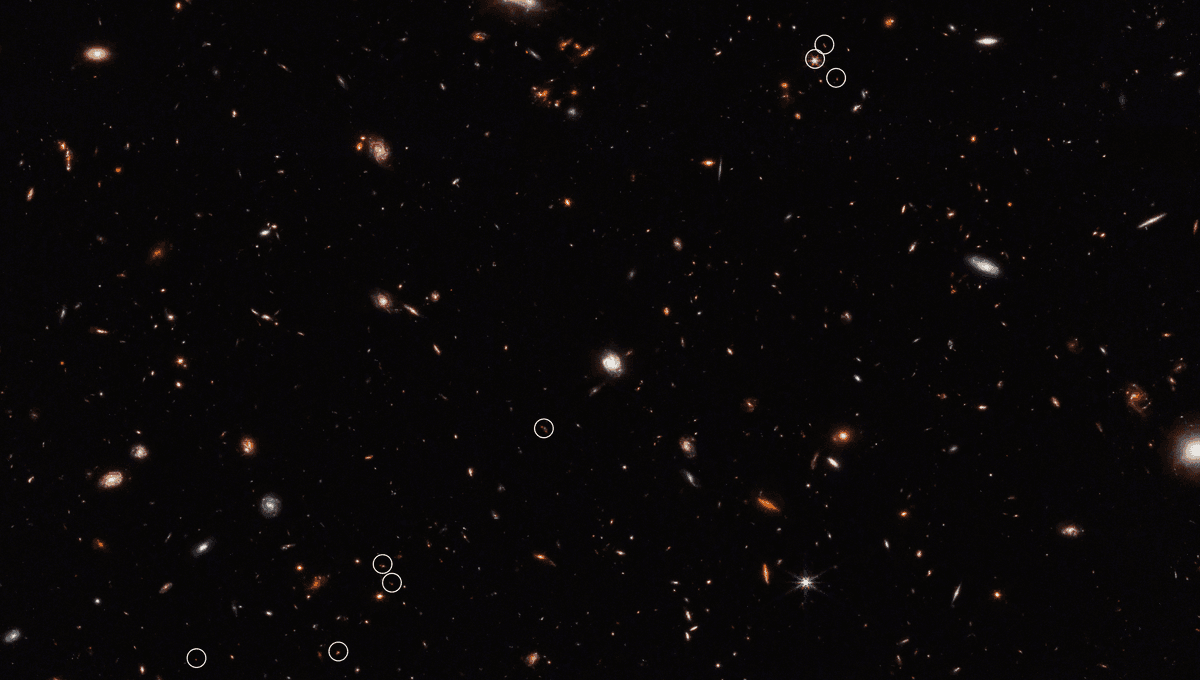
Galaxies big and small are now peppered across the universe like the blueberries in a muffin. They are distributed in what we call the cosmic web, a much less appetizing construct. Galaxies can be quite isolated, or in small groups, or large clusters, but if you zoom out, all these groupings are connected by filaments.
Under the action of gravity, these filaments and the void surrounding them are becoming more prominent. In the beginning, structures were in filaments that were not as well defined but those filaments were there since very early times. And now, JWST has shown the earliest example yet.
Astronomers using the powerful telescope were able to find 10 galaxies placed in what appears to be a thread-like structure that extends for 3 million light-years. Their lights come to us from just 830 million years after the Big Bang and it is anchored around a massive active galaxy whose supermassive black hole is in a quasar state.
“This is one of the earliest filamentary structures that people have ever found associated with a distant quasar,” Feige Wang of the University of Arizona in Tucson, the principal investigator of this program, said in a statement.
“I was surprised by how long and how narrow this filament is,” added team member Xiaohui Fan, also at the University of Arizona in Tucson. “I expected to find something, but I didn’t expect such a long, distinctly thin structure.”
The discovery was part of the JWST program called ASPIRE, which stands for “A SPectroscopic survey of biased halos In the Reionization Era” – certainly a choice, even in the crowded field of peculiar backronyms in astronomy. ASPIRE focuses on the cosmic environment of the earliest black holes to understand the role they play in the evolution of the universe. They are observing 25 quasars to do so.
“The last two decades of cosmology research have given us a robust understanding of how the cosmic web forms and evolves. ASPIRE aims to understand how to incorporate the emergence of the earliest massive black holes into our current story of the formation of cosmic structure,” explained team member Joseph Hennawi of the University of California, Santa Barbara.
The ASPIRE program also aims to understand how supermassive black holes got so big so quickly during the first billion years of the Universe. While smaller supermassive black holes have now been found, the program is looking at eight that range in mass from 600 million to 2 billion times the mass of our Sun.
“To form these supermassive black holes in such a short time, two criteria must be satisfied. First, you need to start growing from a massive ‘seed’ black hole. Second, even if this seed starts with a mass equivalent to a thousand Suns, it still needs to accrete a million times more matter at the maximum possible rate for its entire lifetime,” explained Wang.
“These unprecedented observations are providing important clues about how black holes are assembled. We have learned that these black holes are situated in massive young galaxies that provide the reservoir of fuel for their growth,” added Jinyi Yang of the University of Arizona, who is leading the study of black holes with ASPIRE.
These results are published in two papers in The Astrophysical Journal Letters.
Source Link: Strand Of The Cosmic Web Spotted By JWST Is Earliest Ever Found